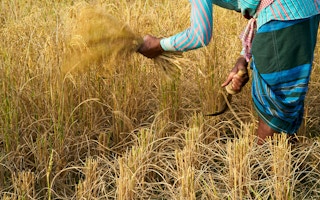About 381 million people in Asia are undernourished, making up about 8 per cent of the population, and the Covid-19 pandemic is likely to worsen the situation, according to the United Nations (UN). In recent years, more countries in the region have turned to food fortification, which is the process of adding micronutrients to food, to arrest this and other malnutrition problems and improve citizens’ health.
In India, for example, the government plans to make fortification of rice, a staple food of over 70 per cent of residents, compulsory by 2023, to improve their nutrition and reduce the rising rate of anaemia. In 2020, Bangladesh partnered with the UN’s World Food Programme (WFP) to start selling subsidised fortified rice to poor households in Dhaka.
Sarwar Mahmud, director general of the Bangladesh government’s food directorate, said that food fortification has become especially important in the wake of the Covid-19 pandemic. “By fortifying rice, we can provide essential vitamins and minerals to households compelled to compromise their food diversity due to limited access to markets and income opportunities during the Covid-19 crisis,” he said.
“It is also a cost-effective way to address nutrient deficiencies in food for disadvantaged urban poor populations,” he added.
Global nutrition, health and sustainable living company DSM was part of the rice fortification effort in Bangladesh. It has collaborated with the WFP, UN Children’s Fund and other humanitarian organisations, governments and firms to develop and distribute cost-efficient and affordable nutritious food in developing countries.
DSM’s alliance with WFP alone has benefited tens of millions of people worldwide since 2007. An ongoing initiative is Project Mandi, short for Making A Nutritional Difference to India, which helps to increase access to nutritious foods in the country in partnership with other non-government groups. DSM also launched Nu-Shakti, a range of fortified food staples including rice, flour and beverage powder, in Tamil Nadu.
From 2013 to 2017, DSM worked with government agencies and ministries in Germany, Thailand, Indonesia, Vietnam and the Philippines, as well as other firms, on the Better Rice Initiative Asia (BRIA), which trained 28,500 farmers across the four Asian nations on the latest farming methods and crop solutions, and encouraged cooking oil producers and rice millers to fortify their products with micronutrients, including zinc, iron and vitamins.
Anand Sundaresan, DSM’s regional vice-president for human nutrition and health for Asia Pacific, said that food fortification will help the region’s growing middle class too. “As people become more affluent, they often have less time to cook and start eating more processed foods, so it’s critical to raise awareness and availability of fortified, healthy foods that give them more micronutrients per serving,” he said.
“
Food fortification can have a tremendous impact, not just on people’s health but countries’ economies, because healthy children learn better, and healthy adults lead more productive lives.
Anand Sundaresan, regional vice-president for human nutrition and health, Asia Pacific, DSM
‘Easiest way’ to boost nutrition
Fortifying staple foods is the easiest way to boost nutrition because people eat such foods daily, said Sundaresan. To boost acceptance of the healthier versions, the fortification process must not alter the familiar look, taste and texture of the foods.
It must also take into account local cooking practices, added Paul Nicholson, vice-president and head of rice research and sustainability at agribusiness firm Olam International, which has teamed up with DSM on several projects, including BRIA. In 2020, Olam launched Ghana’s first and only fortified rice brand, called Royal Aroma Fortified Rice.
“Rice is often rinsed or washed prior to cooking, so nutrients that are simply sprayed on can be washed off. We used DSM’s innovative fortified rice kernels, where rice dough, made up of rice powder and water, is infused with micronutrients and shaped to form noodles, which are then cut very short to resemble rice grains,” said Nicholson.
“These fortified kernels are mixed with natural, traditional rice grains, and are imperceptible in look, taste and cooking quality, so that consumers can seamlessly introduce better nutrition into their favourite dishes,” he said.
Food businesses must also consider affordability, especially if the fortified foods are intended for low-income families. While Olam’s fortified rice is slightly more expensive than its non-fortified rice, it offers different pack sizes to cater to a broad range of customers at different income levels.
“We believe that we can best grow our business by meeting consumer needs through more innovation, and rice fortification is an obvious opportunity with enormous public health benefits,” said Nicholson. “Our cooperation with DSM synergises our respective expertise. DSM knows what forms of fortification are available and appropriate, and we know what defines good quality in consumers’ experience of food products.”
Sundaresan added that governments have a crucial role to play in spurring food fortification. “By setting out detailed and transparent policies on fortified foods, including the types and minimum levels of fortification that are required, they will provide clarity to the private sector and motivate more companies to innovate and join the market,” he explained.
“Food fortification can have a tremendous impact, not just on people’s health but countries’ economies, because healthy children learn better, and healthy adults lead more productive lives,” he said.
Nicholson said food fortification is a proven solution to malnutrition and the persistent challenge of hidden hunger, where people consume enough calories but not enough vitamins and minerals.
“It isn’t a silver bullet, because other factors such as diet diversity are essential too, but it doesn’t require major shifts in food habits, which can sometimes take years or even generations,” he said. “Food fortification can be a powerful tool in transforming the global food system to provide affordable, healthy and balanced diets for all.”






















